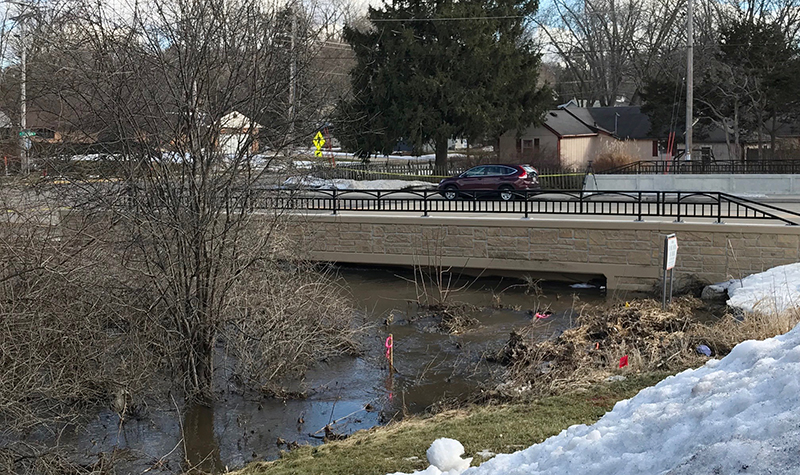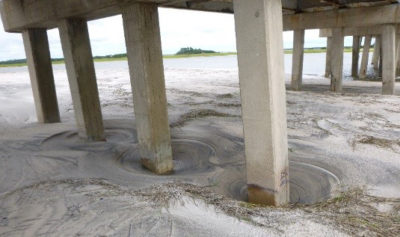Battling Bridge Scour With Research, Inspections, And Training
 Some of the most important foundational elements of a bridge are its least visible – the abutments, piers, piles, and footings submerged under the waterline. That’s where bridge inspectors look for scour – the erosion of soil surrounding a bridge foundation (piers and abutments). Bridge scour occurs when fast-moving water around a bridge removes sediment from the streambed, leaving behind scour holes below bridge foundations. These holes can seriously compromise the bridge’s integrity.
Some of the most important foundational elements of a bridge are its least visible – the abutments, piers, piles, and footings submerged under the waterline. That’s where bridge inspectors look for scour – the erosion of soil surrounding a bridge foundation (piers and abutments). Bridge scour occurs when fast-moving water around a bridge removes sediment from the streambed, leaving behind scour holes below bridge foundations. These holes can seriously compromise the bridge’s integrity.
According to the Federal Highway Administration (FHWA), bridge scour is the leading cause of bridge failures in the United States (approximately 25 to 30 bridges per year). Thousands of bridges are listed as “scour critical” in the National Bridge Inventory (NBI). Without effective countermeasures in place, scour can cause catastrophic results, including bridge collapses and motorist fatalities.

The National Bridge Inspection Standards (NBIS) were established in the 1970s and set up criteria for which bridges need inspections, how often they should be inspected, and who is qualified to conduct an inspection. In general, bridges more than 20 feet long need regular inspections by qualified bridge inspectors. That includes routine inspections every 24 months. Underwater inspections are due every 60 months for bridges over water with portions of the bridge that cannot be accessed without diving equipment.
How Are Bridges Inspected Safely in High-Water Events?
The optimal time to monitor bridge scour is during high-water events, such as during flooding that occurs in many regions each spring due to snow melt and heavy rain. Unfortunately, this can also be the most dangerous and problematic time to assess a bridge because of the fast currents, low clearance underneath, and shifting debris piles resulting from turbulent, swiftly moving water.
The most effective way to maintain the safety of inspectors is to keep them out of harm’s way. One solution being studied by the Michigan Department of Transportation (MDOT) is to use an unmanned surface vessel, also known as USV. The USV is operated remotely and relays data from above and below water back to the operators positioned in a safe location. This research project for bridge scour monitoring includes reviewing and evaluating applicable past research; identifying MDOT’s objectives; preparing a list of equipment for a working vessel; developing operating procedures for vessel and data processing; and providing an implementation plan.
What Levels of Underwater Inspections Are Needed?
The USV or other remotely operated vehicles are not a substitute for up close and personal inspection by qualified inspectors, however. When water levels drop, inspectors who are divers go underwater to conduct hands-on inspections of the portions of the bridge below water. Underwater inspections may be of intensity Level I, Level II, or Level III.
A Level I inspection is a visual, tactile inspection on 100% of the surfaces below water. Inspectors conduct a close visual examination of the entire submerged portions of a bridge. The inspection is detailed enough to detect scour and other deterioration and may include probing the adjacent channel bottom. If water clarity is too poor for a visual examination, inspectors use their hands to carefully check the bridge members.
The Level I inspection may indicate a need for a more detailed Level II inspection. At this level the inspectors must clean marine or aquatic growth from a minimum of 10% of the bridge members below water. This might be accomplished by hand in some freshwater environments; inspectors may need tools to clear critical areas of bridges in saltwater or brackish environments.
A Level III inspection is the most highly detailed of the inspection types and is used when it appears that the structural integrity of a bridge member(s) may be compromised. It involves extensive cleaning, detailed measurements, and nondestructive testing or partially destructive testing using techniques ranging from sample coring to ultrasonics.
When a deficiency is identified underwater that could affect the load-carrying capacity of a structural member, a Level I or II dive can quickly escalate to Level III. For a Level III dive, the effort put forth by the diver, dive team, staff supervisor, client, and owner will also escalate far beyond that of the Level I or II underwater inspection. It takes a systematic approach to first identify the conditions below water and then collect vital information as needed so all parties involved have confidence in the data provided by an underwater inspection.
How Do Inspectors Know What to Look for?
FHWA’s National Highway Institute (NHI) provides several courses on bridge scour that teach engineers and inspectors what to look for underwater and how to keep scour from threatening bridges. Courses include:
- Course 135046 Stream Stability and Scour at Highway Bridges: Comprehensive training on the effects of contraction, pier and abutment scour, stream instability, erosion, and stream aggradation and degradation.
- Course 135047 Stream Stability and Scour at Highway Bridges for Bridge Inspectors: A one-day version of Course 135046, specifically for bridge inspectors.
- Course 135048 Countermeasures for Scour and Stream Instability: Guidance on designing countermeasures for stream instability and scour problems at bridges.
Managing Aging Infrastructure
Scour and other inspection topics will be covered at the 2019 Bridge and Tunnel Inspectors’ Conference, set for April 23-25 in Portland, Oregon. This year’s theme is “Bridge and Tunnel Inspections: Modern Solutions for Managing an Aging Infrastructure.” The purpose of the conference is to provide a forum for inspectors to share information, innovations, ideas, and best practices for inspections and to provide continuing education for inspectors.
Ayres Associates has been at the forefront of scour analysis and evaluation and has a long history of delivering successful research on the topic. The Ayres bridge inspection team has also effectively and safely inspected approximately 30,000 bridges and performed approximately 4,000 underwater inspections throughout the country.

Post a comment: